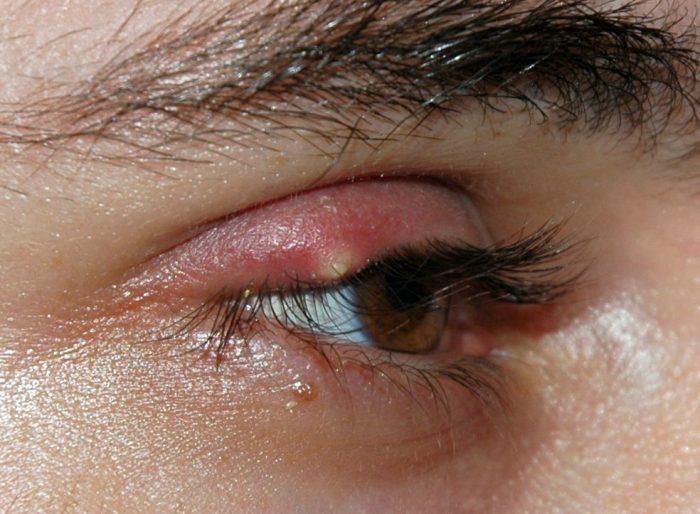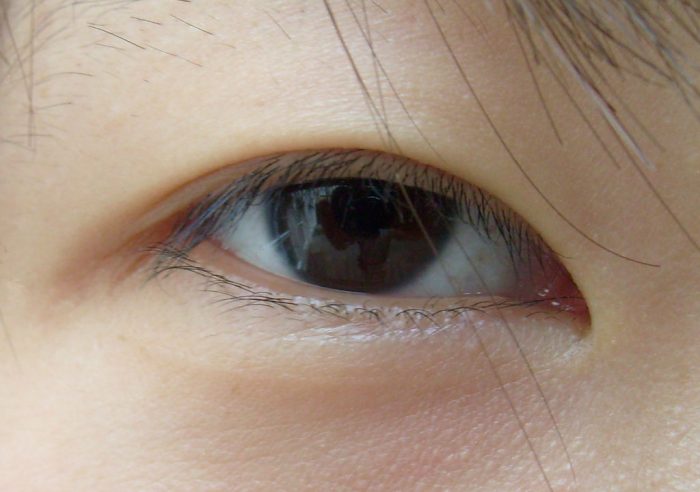
There is a skinfold found on the upper eyelid referred to as the epicanthic fold. The epicanthic old follows the medial canthus or inner corner of the eye, and people with epicanthic folds are said to have monolid eyes.
There are many different variables that influence the development of an epicanthic fold, including various medical conditions as well as ethnic background and age.
The Structure Of The Human Eye

A horizontal view of the right eye. The cornea, iris, lens, pupil and sclera are all present. Photo: By Rhcastilhos. And Jmarchn. – Schematic_diagram_of_the_human_eye_with_English_annotations.svg, CC BY-SA 3.0, https://commons.wikimedia.org/w/index.php?curid=1597930
The human eye is a sensory organ that allows vision and provides information about the outside world to the brain, using light reflected off of objects in the surrounding world.
The human eye is made out of two different pieces fused together. There is a posterior segment and an anterior segment. The anterior segment of the eye is made out of the lens, the iris, and the cornea. The cornea of the eye is made out of a retina, the vitreous, and shell called the sclera. The cornea is bonded to the posterior segment of the eye. The iris is a circular structure with pigment in it that surrounds the pupil of the eye, and the pupil of the eye adjusts to control the amount of light entering it. Light pushes through the pupil and the lens beyond it, entering into the eye through the cornea.
“The eyes are more exact witnesses than the ears.” — Heraclitus
The human eye is a sensitive organ, made out of a soft jelly-like substance. In order to shield the eyes from damage, the human body has several structures that help keep foreign objects out of the eye.
The Eyelid
The eyelid and eyelashes are structures that protect the human eye from things like debris, dust, and sweat. It is a thin flap of skin that covers the human eye, and there is one of the top and bottom of the eye. The eyelid is retracted by a muscle referred to as the levator papilbrae superioris, and the retraction of this muscle exposes the cornea to the outside world. The function of the eyelid is not only to shield the eye from dust and debris but also to spread tears across the surface of the eye which keeps it moist. The cornea must constantly be moist to function properly, and the closing of the eyelid not only spreads tears, but it also spreads other secretions onto the eye. Blinking is an automatic response that is done to shield the eye from potentially harmful foreign bodies, preventing objects from touching the eye.
The eyelid isn’t just one layer of skin, it is comprised of several different layers. From the topmost layer to the bottommost layer, these layers begin with the outer skin and subcutaneous tissue and are then followed by the orbiculis oculi. In the middle is the orbital septum. Finally, the bottom layers are the tarsal plates and the palpebral conjunctiva. Tears are made out of a few different compounds, one of which is lipids. The lipid portion of tears is secreted out of glands referred to as meibomian glands, which are found within the eyelid.
“The human eyelid is not tear-tight (happily for the human eye).” — Samuel Beckett
The upper eyelids are supplied by the lacrimal, supraorbital, infratrochlear, and supratochlear nerves. Meanwhile, the lower eyelid receives sensory nerve supply from parts of the infratrochlear nerve and the infraorbital nerve. The eyelids are also maintained with a blood supply. The blood comes into the eyelids courtesy of two arches, one in the lower lid and one in the upper lid. These arches branch off of the ophthalmology artery and the lacrimal artery. Out of all the patches of skin on the human body, the skin of the eyelid has the highest concentration of sebaceous glands.
Eyelid Disorders

A stye located on the eyelid. Photo: By Andre Riemann – Own work, Public Domain, https://commons.wikimedia.org/w/index.php?curid=670483
Various disorders can affect the eyelid. They can be caused by physical damage to eyelid, bacterial infections, or other sources of abnormality.
A condition known as a hordeolum, also referred to as a stye, is when the sebaceous glands found on the margin of the eyelid become infected. The result is a sometimes painful small bump similar to acne, but styes usually disappear on their own within a week or so. Blepharitis refers to the inflammation of the eyelid margin where the eyelashes protrude from the island. The eyelid becomes inflamed, leading to symptoms like by redness, blurred vision, excessive tearing, dry eye, and light sensitivity. Improving hygiene of the eye frequently solves the problem.
Ptosis is a condition where the upper eyelid sags, frequently caused by muscle deterioration, paralysis or weakness due to congenital conditions, aging, disease or injury. Certain medical conditions like Bell’s palsy and Horner syndrome can make Ptosis more likely to occur.
Entropion can result from either a congenital defect, aging, scars on the inside of eyelid, or eyelid muscles affected by spasms. Entropion refers to the eyelid turning inward towards the globe of the eye.
Edema refers to a condition that causes excess fluid buildup and swollen tissues around the eye. Eyelid edema is typically caused by infections, allergy, or trichiasis. Belpharospams are spasms that affects the eyelid muscle. Eyelid twitching frequently results due to factors like caffeine, stress, and fatigue. Eyelid spasms are rarely serious and are not considered harmful. Consuming less caffeine and getting more sleep will usually solve the issue.
Epicanthic Folds

An example of an epicanthic fold. Photo: By Sarang – Own work, Public Domain, https://commons.wikimedia.org/w/index.php?curid=7398670
Epicanthic folds are most likely to develop in people of Asian descent, though it is by no means exclusive to people of Asian descent. Populations with the highest frequencies of epicanthic folds are found in central Asia, North Asia, Southeast Asia, East Asia, Polynesia, Micronesia, as well as indigenous Americans, Malagasy populations and Khoisan populations. Epicanthic folds may also develop in European populations of Hungarians, Irish, English, Russians, Poles, etc., though they are much less likely to occur. The degree to which a fold develops varies greatly from person to person, and it’s presence on a person may be subjective.
One of the theories for the development of the epicanthic fold is a higher level of fat around the eyeball, which is a feature frequently found in Inuit and Aleut populations. The accumulation of fat tissue, adipose tissue, is theorized to help shelter the eye and sinuses from extreme cold and wind. This manifestation of adaptation to cold, harsh climates can be seen in populations that live in northern, cold regions of the globe.
Despite this, the epicanthic fold has appeared in people of Southeast Asian descent. It is possible that these groups could have descended from ancestors adapted to cold climates. Other theories postulate that the epicanthic fold could help shield the eyes from high levels of ultraviolet light exposure in desert regions of the world, which could account for the appearance of epicanthic fold in people of African descent.
While epicanthic folds can occur normally within large populations, the folds sometimes appear linked with a congenital abnormality. Epicanthic folds are also associated with various medical conditions that lead to the malformation or underdevelopment of the nasal bridge. For this reason, epicanthic folds are prominent in around 60% of individuals with the condition Down syndrome. Other medical conditions that may cause the appearance of epicanthic folds include Zellweger syndrome, Turner syndrome, fetal alcohol syndrome, and phenylketonuria.
Fetuses frequently have epicanthic folds that they lose after approximately six months of gestation.
Different Types Of Eyelid Crease
“My eyes are green, and in one of them there is a splash of brown – apparently it is not a colour, but a freckle! Sometimes I notice that one eyelid droops more than the other.” — Rick Wakeman
The upper eyelid crease is what is used to determine if an individual has a single eyelid (monolid), or a double eyelid. There are various types of eyelid creases that individuals may have. As mentioned, a monolid is where the eyelid crease is absent, with no fold or crease separating the lid into two different parts.
However, individuals may also have a partial eyelid crease. A partial eyelid crease is where an eyelid crease is present but potentially undefined or does not extend across the entire range of the eyelid. This type of crease may end up becoming more defined as the individual ages due to the skin above the crease becoming looser with age. Multiple eyelid creases are also possible. In addition, individuals may have a tapering eyelid crease, where the crease narrows as it approaches the inner corner of the eye.
Eyelid Surgeries
Blepharoplasties are eyelid surgeries. They can be done for either cosmetic reasons or for medical reasons. Eyelid surgeries may be carried out to treat conditions like eyelid tumors, trichiasis, ptosis, and chalazion. Cosmetic eyelid surgeries are usually done to give the eyelid a more youthful appearance, removing excess fat and skin that comes with age. While eyelid surgeries are safe procedures in general, because the operation is performed so close to the eye itself they do carry certain risks such as damage to the eye.
Blepharoplasties are some of the most common surgical procedures in the world, with around 1.4 million people having the procedure done in the year 2014. East Asian countries see a particularly high procedure rate, as in countries like South Korea and Taiwan the procedure is a popular aesthetic operation done with the goal of increasing the upper eyelid.









